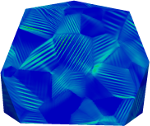|
|
|
|
The Symposium Dear colleagues, The IUTAM Symposium on "Generalized continua emerging from microstructures " will take place at Mines ParisTech on July 19-23 2021. You will find useful information and indications to arrange your venue here. The registration fee for those who will physically attend the conference is 120€. For those who will participate remotely, registration is free. Payment must be made by bank transfer to the following account: All the abstracts have been submitted and are now accepted. You can download the Book of Abstract here. The program conference has been established. It can be consulted on the dedicated page, and can be downloaded here. The conference organizers will be monitoring the Covid-19 situation closely. In order to ensure the safety of the participants, the organizers will be following guidelines of the World Health Organisation and applicable government guidelines. More information about the sanitary condition to travel and stay in France are provided here. We thank you for you understanding and cooperation, Sincerely,
Symposium Scope The mechanics of generalized continua has become a well-established field of continuum mechanics of materials and structures, with many applications in computational mechanics. It includes gradient approaches (strain gradient media or gradient of mechanical variables like plastic strain or damage parameters) and higher order continua that rely on the introduction of additional kinematic degrees of freedom (Cosserat or micromorphic theories for instance). It is now well-accepted that such approaches are necessary in particular for the analysis of strain localization phenomena, up to fracture. They are also very effective for the description of size effects in the linear and nonlinear mechanical behavior of materials and structures. However, the formulation of such models very often remains purely phenomenological even though the origin of the generalized contributions is attributed to the underlying microstructure. The objective of this symposium is to bring together experts in the field of generalized continua and homogenization methods in order to elaborate strategies for the construction of higher order theories starting from the detailed knowledge of the properties of the microstructure. The main features of the microstructure are very often of discrete nature: defects in crystalline solids or granular media, beam networks or unit cells in architectured materials or composites. How to predict size effects and the associated effective characteristic lengths from the collective behavior of defects under load or from the unit cell deformation fields in periodic media? Fruitful discussions are expected between experts in the development of thermodynamically consistent phenomenological strain gradient theories and specialists of homogenization and coarse graining methods. The targeted material and structural properties are the static elastic-plastic and damage responses but also the dynamic behavior of architectured materials. The dispersion of waves in heterogeneous materials like metamaterials can be described successfully by generalized continuum models. We expect that the meeting of experts from different communities will result in common or alternative strategies to address scale bridging from microstructures to generalized continua. Generalized continuum models can be only validated by comparison and identification with field measurements which are now striving in experimental mechanics: crystal lattice orientation and dislocation density field by diffraction, strain field measurements by digital image correlation. This experimental information will be presented in the Symposium.
Scientific Committee P. Gumbsch (KIT, Karlsruhe, Germany)
Organizers Samuel Forest (CNRS Research Director, Centre des Matériaux, Mines Paris) Local Organizing Committee Samuel Forest Aldo Marano Sandrine Laurent-Fontaine Jean-Michel Scherer
|
| Online user: 2 | Privacy |

|

